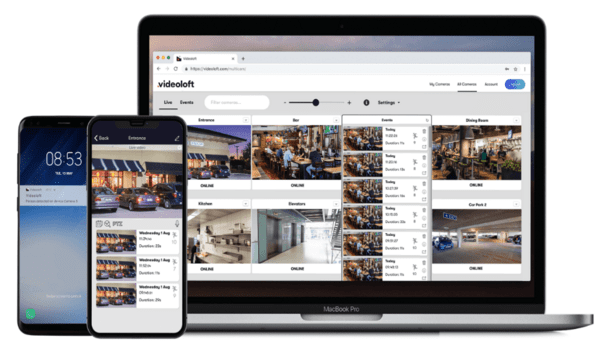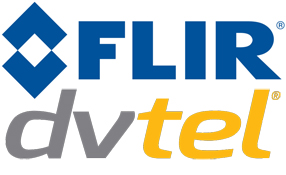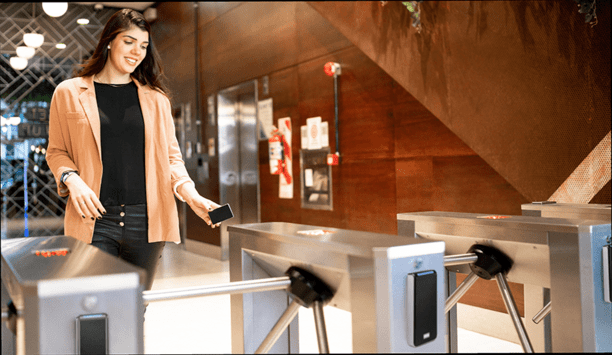Lorex Technology Inc - Experts & Thought Leaders
Latest Lorex Technology Inc news & announcements
Videoloft is bolstering its presence in the United States by hiring new U.S. based sales staff and integrating with established brands in the US market, including Digital Watchdog, exacqVision, Vivotek and Lorex. Videoloft focuses on transforming traditional professional surveillance systems into cloud connected solutions via the Videoloft Cloud Adapter. The company was born from the innovative technology created for the Manything app in 2012, which turned old smartphones and tablets into ad-hoc DIY home-monitoring cloud cameras and now boasts over 1 million+ users. Proactive and personalised The versatile and highly cost-effective Videoloft cloud solution can serve either as a backup to local recorders or as a primary recording method, sending video footage direct to the cloud at up to 8MP resolution. The solution employs rigid security protocols to ensure all video is transmitted and stored securely in the Videoloft cloud, which is hosted on Amazon’s AWS. Videoloft end-users have remote access to their cloud video surveillance system from anywhere and at any time via the Videoloft mobile app or web-based VMS. It makes security systems highly proactive and personalised and instantly upgrades legacy systems with new features. Competitive Pricing Videoloft’s partner pricing is extremely competitive and is approximately 8 to 10 times less expensive Videoloft’s partner pricing is extremely competitive and is approximately 8 to 10 times less expensive than other cloud providers. The platform is compatible with pioneer brands, has an impressive feature set including video analytics and remote installation, as well as a proven ability to send video to the cloud over real-world uplink speeds. Exceptional results Selling predominantly via the channel, Videoloft’s cloud-based VSaaS solution is rapidly being adopted by professional security dealers and systems integrators who add Videoloft cloud to their customers’ surveillance systems. The solution is being used with exceptional results by a wide variety of users ranging from homeowners to restaurant chains and healthcare facilities to cannabis growers and dispensaries. Videoloft offers two white label versions of their platform, with over 150+ white label solutions already deployed by national distributors and integrators. Videoloft users span 160+ countries and generate the equivalent of 25 years of video monitored by the Videoloft cloud every day.
Imperial Capital estimates DVTEL has revenues of $35 to $45 million, growing at well over 10 percent annually On 30th November 2015, FLIR Systems announced it acquired DVTEL Inc., a provider of enterprise-class security and video surveillance solutions, for $92 million in cash. Commenting on the transaction, Imperial Capital views the announcement very positively. DVTEL is a leader in software and hardware technologies for advanced video surveillance. Imperial Capital estimates the company has revenues of $35 to $45 million, growing at well over 10 percent annually. Therefore, the price FLIR is paying for a highly-regarded industry technology and full solutions leader, at about 2x revenue, is not high, according to Imperial Capital. The following additional commentary on the FLIR/DVTEL deal is provided by Jeff Kessler and Saliq Khan of Imperial Capital. View We are maintaining our Outperform rating and our one-year price target of $40 on FLIR shares; our price target is about 30% above the recent share price. Many may still consider FLIR as just a premier provider of very high-end cameras in the bellies of Bell Helicopters in a very uncertain government sector. However, this 35-year-old company is a global leader in thousands of infrared detector cores and thermography equipment markets and also provides lower-priced products to the commercial and consumer security customers as well as other customers (e.g., automotive, boating, Original Equipment Manufacturers [OEM], smart grid.) Rationale DVTEL is a privately-held company and, though its brand may not be as well-known as other companies, its technology and industry vision has always been at the industry forefront, and it has won many product awards. DVTEL develops true broad-based video solutions, for large companies such as Google, mainly for the enterprise level market, but the company’s medium business solutions include: Open platform for other camera manufacturers; A highly rated “Latitude” Network Video Management System (NVMS); A full set of video analytics developed through its acquisition of ioimage in 2010, one of the strongest analytics suites on the market; Cameras, encoders and video analytics. DVTEL developed an industry-firstmobile video application that turnsmobile smartphones intofull-featured IP video surveillancecameras DVTEL has developed many cutting edge products over time that remain innovative, but under FLIR could be marketed and commercialised with a strong brand behind them, particularly because FLIR is an industry leader in providing cloud-based services in which customers can view and manage each of their site installations, gain access system health reports, receive email alerts upon system status changes, etc., allowing end users to detect and cope with problems before they occur, saving time, money and on-site visits. Storage and transmission improvements DVTEL developed an industry-first mobile video application that turns mobile smartphones into full-featured IP video surveillance cameras that stream video into DVTEL’s Latitude Network Video Management System. [They are a] leader in the new group of 4K super high definition cameras that can be used for gaining four times the evidentiary detail with minimal impact to storage costs, relative to the older standard 1080 pixel, that can drastically improve the stability, range, and detail of video images for evidence. Meanwhile, DVTEL is developing storage and transmissions improvements to keep both bandwidth and cost issues in line. Mixing strengths and weaknesses DVTEL’s technology and solution focus is “cool,” but there are additional reasons supporting our positive view on the new acquisition. There are several strategic fits of mixing strength and fixing weaknesses in acquiring DVTEL: The acquisition of DVTEL is a directchallenge to the integration communityto now take a full solution from FLIRseriously FLIR has already demonstrated it knows how to integrate video acquisitions, such as the October 2012 acquisition of Lorex Technology, which take up the low and medium end of video cameras and total video solutions. Right now, FLIR is still known in the security industry as a high quality niche participant in thermal infrared imaging for specialty purposes, even though its generation security camera offerings have garnered wards of their own. The company is now known as a full video solutions provider, which is what Canon is trying to do with its recent acquisitions of Axis Communications (cameras) and Milestone Systems (VMS). The acquisition of DVTEL allows FLIR to become a major participant in the full solutions market, by already being a significant and respected manufacturer of cameras, and core miniaturisation, along with thermal technology and a developing hybrid visible light/thermal capability. DVTEL brings FLIR a very high technology capability analytics (something that FLIR has been stressing in all its trade show and security conference meetings and in meetings with investors), as well as a well-respected VMS. DVTEL brings a true open system capability to FLIR with a wider range of SDKs (software development kit) than even FLIR has. Despite some major successes in the last couple of years, DVTEL still lacks a big brand name and has little impact in the consumer and small and medium business (SMB) space, where FLIR has made a big impact with its acquisition of Lorex Technology. The acquisition of DVTEL is a direct challenge to the integration community to now take a full solution from FLIR seriously, as the other major North American choice has had some controversial management moves. Whether or not FLIR can challenge the full solution being put together (albeit with declared strong “Chinese Walls”) of Canon Inc., Axis Communications and Milestone Systems has yet to be seen. We still believe the low-cost camera arena is increasingly being dominated the large Chinese manufacturers, who may eventually get smarter about offering more open, better full video solutions However, our understanding is that there may be some resistance by end-customers to Asian video analytics solutions at the SMB and Enterprise level of the security industry. Jeffrey KesslerInstitutional ResearchImperial Capital Saliq KhanVice President of Institutional ResearchImperial Capital
FLIR® branded products will be introduced through Digimerge’s network of major security distributor partners FLIR Systems, the world’s leading innovator and supplier of thermal imaging technology, has acquired Lorex Technology, and its subsidiary company Digimerge Technologies. FLIR® branded products will soon be introduced through Digimerge’s well-established network of major security distributor partners, and will quickly grow to include a full line of affordable DVR’s, Analog Cameras, NVR’s and IP Cameras. FLIR will also integrate its thermal imaging technology into a new line of ultra low-cost cameras which will enable distribution channel customers to realise the advantages of thermal video. "For years FLIR has been working towards a continual reduction of the costs of thermal imaging technologies with the ultimate goal of providing thermal imaging technology to a very broad base of users at very low cost," said Andy Teich, president of FLIR’s Commercial Systems division. "From a technology standpoint,” continued Teich, “we bring to Digimerge a different and much more effective means to see in total darkness. Ultimately, we will be able to bring the Digimerge customer base a true 24/7 imaging capability, and a greater offering of combined thermal/visible solution, which we believe provides the best of both worlds." While the Digimerge product line has been successfully marketed toward the SMB segment to meet everyday security needs, FLIR’s extensive assortment of sensor systems technologies have become trusted in a variety of large enterprise level industrial and commercial markets including airborne, automotive, maritime, military, and law enforcement. Wayne Hurd, Executive Vice President of Digimerge, added “we are very excited to combine forces with the formidable FLIR organisation and deliver its highly regarded brand to our customer base. Furthermore, we look forward to working with FLIR’s extensive international team to further our product lines’ reach. FLIR brings a wealth of incredible technological capabilities which we are eager to incorporate into our product line and take our combined businesses to new heights.”
Insights & Opinions from thought leaders at Lorex Technology Inc
For businesses today, loss prevention is no longer just about safeguarding inventory from theft. While retail theft makes frequent headlines in the United States, and is indeed the leading cause of shrinkage, The National Retail Foundation (NRF) has reported that process failures, operational inefficiencies and employee theft also drive significant losses. Legacy security systems In 2022, the shrink loss is estimated to be $ 120 billion in the United States, and that’s for retail alone. Industries like hospitality, healthcare, manufacturing, and transportation all face similar challenges even though loss and inefficiency take different forms in each of these fields. As shrinks from theft and operational inefficiency have already put margins of companies under pressure, we are increasingly seeing more businesses demand AI-powered security systems with advanced video analytics, capable of addressing both security and operational inefficiencies that their legacy security systems could not. Understanding the full scope of loss Package theft is a common problem in commercial buildings, with which box detection in mailrooms Starbucks’ recent announcement of reinventing its franchise operation due to faltering sales is a great example of how operational efficiency can take a toll on business revenue. In restaurants or hotels, failing to anticipate customer flow can lead to long wait times or inefficient use of staff, frustrating guests. Take, for example, in hospitals, inefficient patient flow management can lead to overcrowded waiting areas and delays in care, compromising patient health. Similarly, in manufacturing, poorly optimised assembly lines create production bottlenecks, delaying output and raising overhead. Package theft is another common problem in commercial buildings, with which package detection in mailrooms can mitigate loss from deliveries. These invisible leaks creepingly drain profits across industries, and require future-proof solutions that not only confirm what’s already known but also provide actionable insights for improvement. Transforming security into a powerhouse for efficiency Progress continues to advance across these areas, fuelling optimism for what lies ahead. Thanks to the rise of artificial intelligence and data analytics, some security solutions are already integrated with facial recognition and licence plate detection capabilities, as well as Virtual Fences that help ensure that only authorised personnel or vehicles enter sensitive areas. This can be especially useful for manufacturing environments, where controlling access to high-risk zones and protecting valuable assets are critical. Some modern security systems can even offer more than a watchful eye, doubling as a data analytic tool beyond traditional surveillance limits. Heat mapping in security AI technology Heat mapping in security AI technology analyses ways of movement and behaviour in a retail environment Modern security systems are now capable of tracking foot traffic, analysing customer behaviour, and even identifying bottlenecks in real time by incorporating different technologies such as heatmapping, people counting and queue length monitoring for long lineups. Heat mapping in security AI technology analyses patterns of movement and behaviour in a retail environment by visually representing areas with high foot traffic. With tracking over time and identifying potential vulnerable and hot spots for potential theft and fraud, resulting in change of store layout, deploy additional resources in high traffic areas and physical security placement. Predictive security analytics AI people counting in security utilises sensors and cameras to accurately track the number of individuals entering and exiting a space in real time. This data helps businesses optimise staffing levels, enhance customer experience, and improve overall operational efficiency by aligning resources with foot traffic trends. Predictive security analytics, such as heat mapping and people counting, are not new inventions. But I believe the ability to integrate all these functionality into a single system will allow these technologies to further mature and expand their footprint in near future. Rather than relying on separate tools for each business function, businesses can now use a single, integrated system to gather actionable data while continuing to secure protection through video surveillance. You Can’t Manage What You Can’t Measure AI-powered security systems give businesses access to a wealth of data that they can use AI-powered security systems give businesses access to a wealth of data that they can use to precisely pinpoint where losses are happening. This is key to solving the problem of shrinkage, which often goes beyond simple theft. Consider the Starbucks case mentioned earlier, while Starbucks hasn't specified how it plans to achieve operational efficiency to “enhance the cafe experience”, an AI-powered security system could provide an all-encompassing solution to minimise bottlenecks during peak hours, optimise store layouts, and allocate staff more efficiently. The impact of this technology can be tremendous as it not only enhances the customer experience but also reduces inefficiencies that contribute to lost revenue. By analysing patterns, conducting Forensic Review with Smart Search to quickly locate incidents, and understanding the root causes of loss, companies can implement targeted solutions that reduce shrinkage and streamline operations. Future-proof solutions Walmart is using foot traffic analytics to predict demand and manage inventory Companies like Walmart are already using foot traffic analytics to predict demand and manage inventory. But beyond basic predictive inventory analysis and crowd control, the data gathered will have the potential to be combined with other business functions, smart energy management, pricing and marketing strategy, just to name a few. Investing in a security system that integrates AI video analytics, such as package detection, queue length monitoring, and Virtual Fences, can provide future-proof solutions that also enhance operational efficiency. Looking ahead With New York State's introduction of new Retail Security measures to encourage businesses to strengthen their security, we've seen increased interest. However, modern security systems with real-time analytics are now offering companies more than just protection—they’re providing valuable insights into operations, transforming security from a cost burden into a powerful tool for growth and efficiency. As businesses continue to adopt AI-powered security systems, it's clear that the role of security is evolving beyond traditional surveillance. These advanced systems are no longer just about protection, but help businesses grapple with increasingly complex challenges. By transforming security from a reactive expense into a proactive, data-driven asset, companies can stay ahead of the curve, managing not only what they can see, but also what they’ve been missing.
A major industry player is getting even bigger. FLIR’s acquisition of DVTEL will make FLIR a full-spectrum security systems provider, covering the consumer, SMB, Enterprise and large infrastructure segments of the market. The acquisition of DVTEL strengthens and broadens FLIR’s Enterprise market segment, complementing the existing security product lineup by offering a new set of software-based video surveillance technologies. FLIR already has solutions at either end of the traditional Enterprise business – Consumer and Borders, as examples – and FLIR’s existing solutions will be strengthened further with the addition of DVTEL’s products, technologies, and development capabilities. “We believe this is a unique position in the overall market,” says John Distelzweig, Vice President and General Manager of FLIR’s Security Segment, who also provided other insights into the benefits of the recent acquisition. SourceSecurity.com: Was there any aspect of DVTEL that made it an especially attractive acquisition target? Distelzweig: DVTEL adds key video management software and video analytics software to FLIR’s product suite to allow FLIR to offer an end-to-end solution for customers. SourceSecurity.com: How will the "sum be greater than the parts?" Distelzweig: DVTEL gives FLIR an impressive VMS platform from which to brand FLIR, expanding our presence from a strictly Enterprise market to the SMB (small- and medium-sized business) market. DVTEL’s video analytics algorithms are widely viewed as the industry’s best, and FLIR will incorporate them into our existing products to create a best-of-breed, highly-reliable and advanced automated alarming solution. This will help drive incremental value for existing FLIR products. Additionally, expanding the DVTEL camera lineup with FLIR cameras at either end will drive incremental revenue on a per-project basis. SourceSecurity.com: FLIR in the security market still tends to be associated with thermal cameras. This acquisition seems to be an additional way to expand beyond that core technology (and its perception as an expensive option). FLIR has been an innovator inthe Thermal Security Space foryears. The addition of industry-leading Video Analytics isclearly complementary Distelzweig: FLIR has historically been a high-end, even military, brand. However, in the past two years, with the integration of Lorex, FLIR now has an established brand in the SMB space and even in Consumer IP (FLIR FX for example). With this most recent move, the FLIR brand stands for best value and performance in every category. SourceSecurity.com: Did the broader appeal of thermal cameras in the market (based in part on lower costs) impact the decision to buy DVTEL (i.e., make it a better “fit”)? Distelzweig: In short, Yes. FLIR has been an innovator in the Thermal Security Space for years. The addition of industry-leading Video Analytics is clearly complementary to this positon. With the introduction of the Lepton thermal micro-core, we are positioned to push the price points for perimeter solutions to a completely new level. Expect exiting things to come in this regard. SourceSecurity.com: FLIR is active in so many markets, what does this acquisition say about the company's "commitment" to video surveillance? Is there any aspect of this acquisition that could impact any other markets the company serves? Distelzweig: FLIR is very committed to all of its markets. Video Surveillance is a component in the products in four of our existing segments today (Security, Surveillance, [OEM/emerging markets/intelligent traffic systems], and even in Maritime). In each of these cases the products and/or technologies from DVTEL will bring improvements to the solutions being offered today. SourceSecurity.com: Can you tell us anything about the changes that are likely to occur related to DVTEL's personnel, locations, use of the brand name(s), etc.? Distelzweig: DVTEL will report in our existing security segment. The DVTEL sales force will be folded into our existing team, adding complementary regional and functional positions. DTVEL product development will remain in their current locations, and FLIR will utilize them for more innovation under its long-term strategy in the Security market.
Using artificial intelligence (AI) to automate physical security systems
DownloadA modern guide to data loss prevention
Download7 proven solutions for law enforcement key control and asset management
DownloadThe truth behind 9 mobile access myths
DownloadAccess control system planning phase 2
Download










